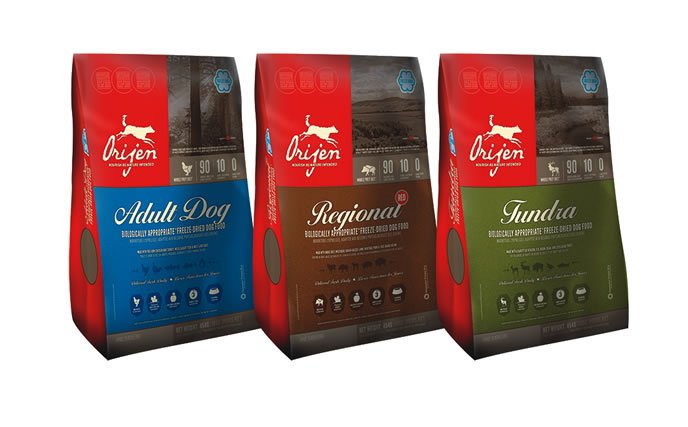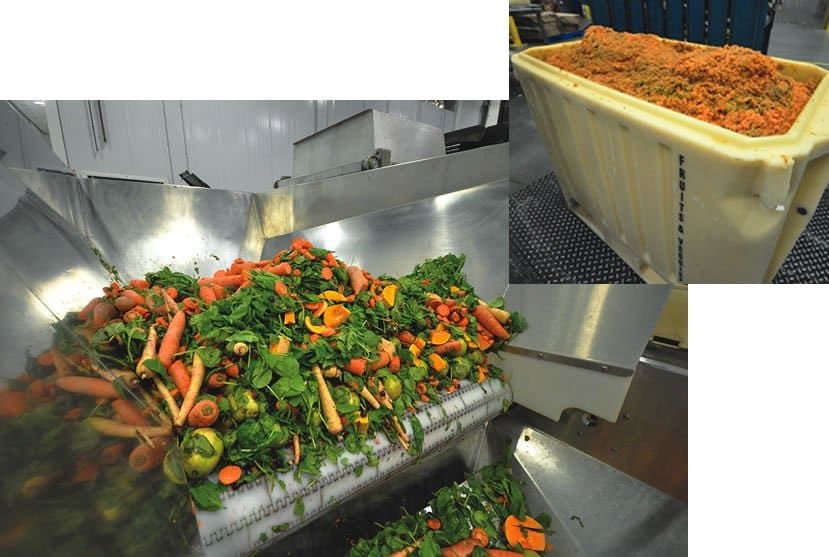
Champion Petfoods is a privately held company that makes high-protein dry dog foods with a high inclusion of meat, much of it fresh. The company calls its guiding principle “BAFRINO,” an acronym that stands for “biologically appropriate, fresh regional ingredients, never outsourced.” As of this writing, all of Champion’s dry foods are made in its own manufacturing plant in Morinville, Alberta, though the company is currently building a second dry food manufacturing plant in Auburn, Kentucky. Champion also manufactures freeze-dried foods at its own plant in Oakville, Ontario.
When I started researching and writing about dog food 18 years ago, I was told by many pet food company representatives that dry dog food couldn’t be made with a meat inclusion of more than a third or so. In other words, the food couldn’t contain much more than about 30 percent animal products; any more meat in the food, I was told again and again, and the manufacturer risks having the product “gum up” the extruders – the equipment that cooks the food.
I suspect this was an oversimplified explanation meant to rationalize the companies’ carbohydrate-heavy formulas of the past. As animal nutrition studies have shown that higher-protein diets are not harmful for dogs (as thought in decades past), and owners have found them to be beneficial for all sorts of dogs, diets that contain higher amounts of animal protein have become increasingly popular – and somehow, pet food makers have found ways to get their extruders to work with increasingly higher and higher inclusions of meat in their formulas.
I’m not aware of any company that is currently using higher percentages of meat in their dry dog foods than Champion, though; it’s actually become an integral part of the company’s identity and mission. More than 30 different types of meat are delivered to Champion’s plant, with 10 or 11 semi-trucks full of meat arriving daily, six days a week. The majority of these meats are fresh; some meat meals are used, but no frozen meats are included. The fresh meats arrive to the Champion plant in refrigerated tubs of meat “slurry,” pre-ground by Champion’s meat suppliers.
Ingredient sourcing
Champion puts more emphasis on its ingredient sources than any other company I’ve observed. Company representatives take pride in their close relationships with their ingredient suppliers – and in fact, many of those suppliers appear (with their consent, of course) in Champion’s advertising, packaging, and promotional materials. Champion’s marketing materials feature photos and video of fishermen bringing in the catch, farmers harvesting fresh herbs, and ranchers moving their cattle, bison, and “wild boars” from pasture to pasture – and the individuals and their agricultural businesses are identified, so these relationships can be verified by anyone.
This strategy runs counter to the more-common practice in the pet food industry of refusing to disclose ingredient sources. It’s a tad risky, because any adverse events that strike an ingredient supplier could cause concern over Champion’s products – whereas, if consumers don’t know where a company gets its ingredients, they have no basis for worrying about a specific company’s food. Champion researches and audits its ingredient suppliers frequently, and makes them aware that the reputation of the companies on both sides of the relationship are intertwined. Many of the suppliers sell as much or more of their products for human consumption; none of the companies want bad press! Champion trusts its suppliers to provide top-quality, safe ingredients, and in turn, the suppliers trust Champion to manufacture safe, healthy foods that won’t make dogs sick or get recalled.
Maintaining these close relationships is manageable because of the part of Champion’s mission statement that addresses “fresh, regional ingredients.” All the major ingredients in Champions’ foods are sourced as locally as possible – from Canada or the U.S. Of course, some of the fresh fruits and vegetables used in the foods are not available year-round in the far north, and have to be procured farther afield, but the quality control processes are the same.
Champion is developing new formulas, to be produced in its Kentucky facility, starting in 2016, that will contain ingredients that are sourced close to the new location.
Original line: Acana
Champion has two distinct dry food product lines, and while both are formulated according to the company’s BAFRINO ethos, they are nevertheless significantly different.
Acana is the name of the line of foods that Champion first produced about 30 years ago. Company founder Reiner Muhlenfeld had a background in feed stores, and began producing a private-label dog food to sell as a store brand. Though Acana has been updated and reformulated throughout the years, it has always been formulated with locally sourced ingredients. Today, there are three sub-lines made for the Acana label: Classics, Regionals, and Singles.
The nine Classics formulas are made with a 55 percent to 65 percent meat inclusion; chicken meal (not a fresh meat) is the first ingredient in each variety, with smaller yet significant amounts of fresh meats and fish and whole eggs contributing to the total inclusion of meat (and adding flavor). Oats comprise the foods’ major carbohydrate source. Each food is formulated to contain 32 percent protein and from 10 percent to 24 percent fat (depending on the variety). (Note that all protein and fat percentages given are minimums; the “actual amounts” may be higher.)
There are four Acana Regionals foods. These contain 60 percent meat, and each variety’s ingredient list is topped by a different fresh meat, with a meat meal in the second position on the label; other fresh meats are also included in each formula. All of the products in this line are grain free; the carbohydrate sources used include peas, lentils, field beans, potatoes, sweet potato, pumpkin, butternut squash, and parsnips, depending on the formula. Each product contains 17 percent fat and 31 to 33 percent protein (depending on the formula).
Champion offers three Acana Singles foods, each made with a single animal protein source. Each variety contains the same animal protein (pork, lamb, or duck) in meal and fresh form, with fat from the same species added separately. These foods are also grain-free, with the meat comprising 50 percent of each formula and 50 percent comprised of fruits and vegetables. Peas, chickpeas (a.k.a. garbanzo beans), and pumpkin are the carbohydrate sources. Each product has a protein of 27 percent and 15 percent fat.
Some sort of fish appears on the ingredient list of every Acana food. Champion sources some of its fish from freshwater lakes in Canada, and some (salmon, herring, and flounder) from the Pacific waters near Vancouver Island.

Flagship line: Orijen
Almost 10 years ago, Peter Muhlenfeld (the company founder’s son) developed a new product line, Orijen – which has since become Champion’s flagship label, representing about 60 percent of the company’s output. These foods contain even higher meat inclusions, higher protein levels, and are priced higher as a result. Champion says its Orijen foods are made with 75 to 90 percent meat inclusions. The ingredients list of each of its seven Orijen formulas are topped by a fresh meat, and contain a number of other fresh meats, though all seven also contain one or two meat meals. The Orijen line includes two puppy foods, with 38 percent protein and 16 percent (large breed puppy) or 18 percent (regular puppy) fat. Its senior food also contains 38 percent protein, with 15 percent fat. Its four adult foods all contain 38 percent protein and 18 percent fat.
More recently, Champion began making a line of Orijen Freeze Dried foods, which it makes in its own facility. All three products in the line contain fresh meats (no meat meals) that are ground with fresh bone (as a mineral source). They contain a minimum of 36 percent protein and 34 percent fat.
Notes
– Champion does not use a standard vitamin/mineral mix in its foods, but adds only those nutrients that are needed to make the finished product meet “complete and balanced” standards. This eliminates needless nutrient overages.
– The company describes its extrusion process as a “slow cook” at “lower temperatures.” While this is technically true, the difference is just a few seconds and a few degrees in the extruder. The difference is necessitated by the formulas’ higher animal protein and fat content.
– Water does not appear on the ingredient label of dry foods, even though most manufacturers use water to help mix the food before it’s extruded. No water is added to Champion’s mixtures, because so many of their ingredients are freshly ground and high in moisture already.
– As a privately owned company, Champion is under no obligation to disclose annual sales figures or even tonnage of product manufactured annually. The company has grown exponentially in the past decade, but its principals admit that it is limited by its ingredient procurement standards.






